Ethical Decision Making: Scenario 5 - School Counsellor
VerifiedAdded on 2022/11/17
|7
|2620
|401
Report
AI Summary
This report analyzes an ethical dilemma faced by a school counsellor, Ivor, in Scenario 5. The case involves a 15-year-old student, Tess, who died by suicide. The core issue revolves around whether Ivor should disclose the reasons behind Tess's death to her parents, considering Tess's confidentiality and the family's cultural background. The report explores the competing ethical principles of privacy versus disclosure, and how Ivor can use an inclusive decision-making model to navigate the situation. The report also examines the ethical perspectives of the social worker, Niri, and the importance of cultural sensitivity. It emphasizes the need to consider the potential consequences of disclosure, such as the parents' well-being and the risk of family conflict, including the potential for the grandfather to be accused of sexual abuse, as revealed in Tess’s letter. The report also highlights the importance of reflective analysis and considering what could have been done differently during the counselling sessions to prevent the tragic outcome, particularly in relation to assessing the risk of suicide. The report concludes that Ivor should not disclose the reason to the parents and take into account the parents' mental well-being and the potential for causing a crime.
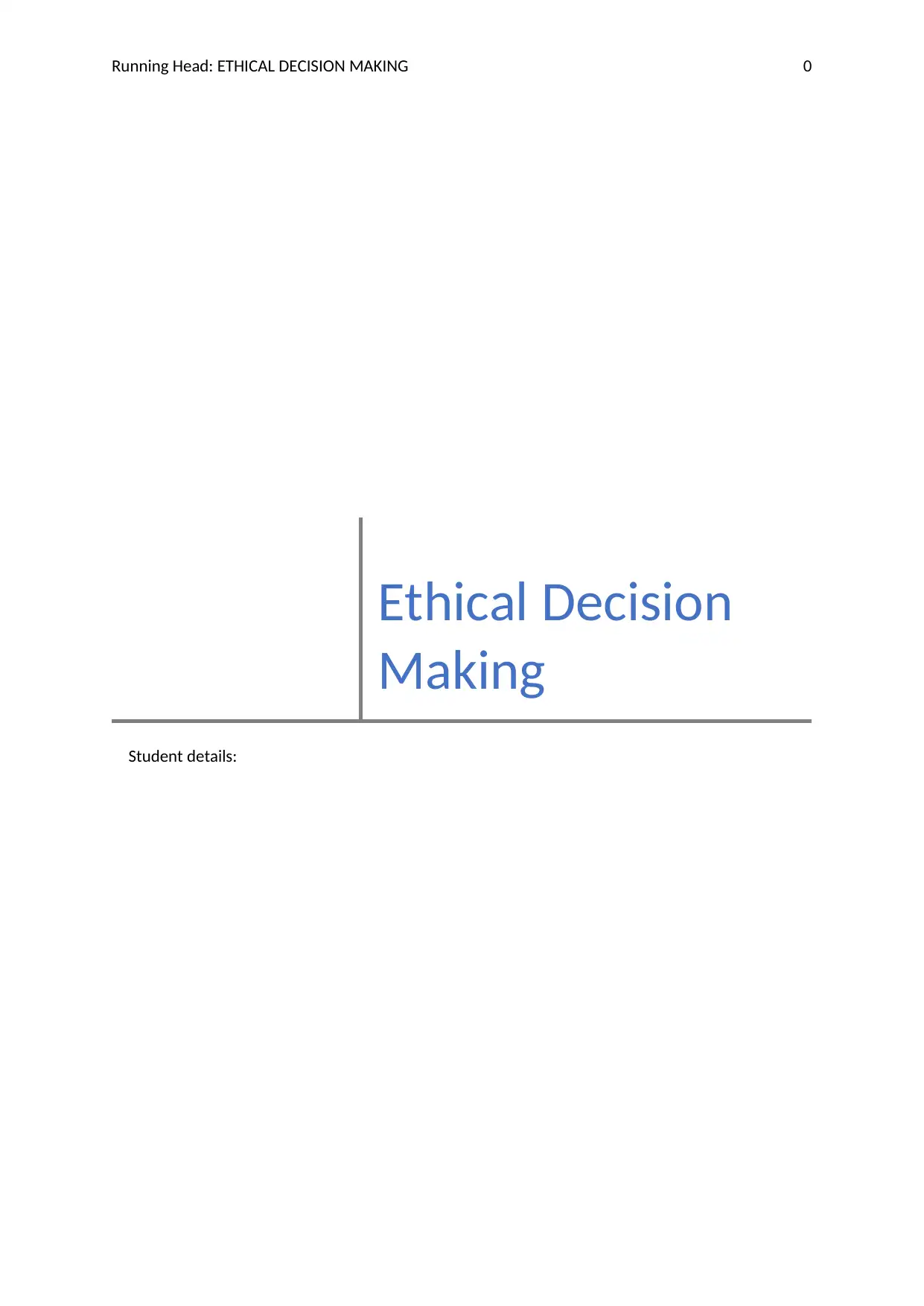
Running Head: ETHICAL DECISION MAKING 0
Ethical Decision
Making
Student details:
Ethical Decision
Making
Student details:
Paraphrase This Document
Need a fresh take? Get an instant paraphrase of this document with our AI Paraphraser
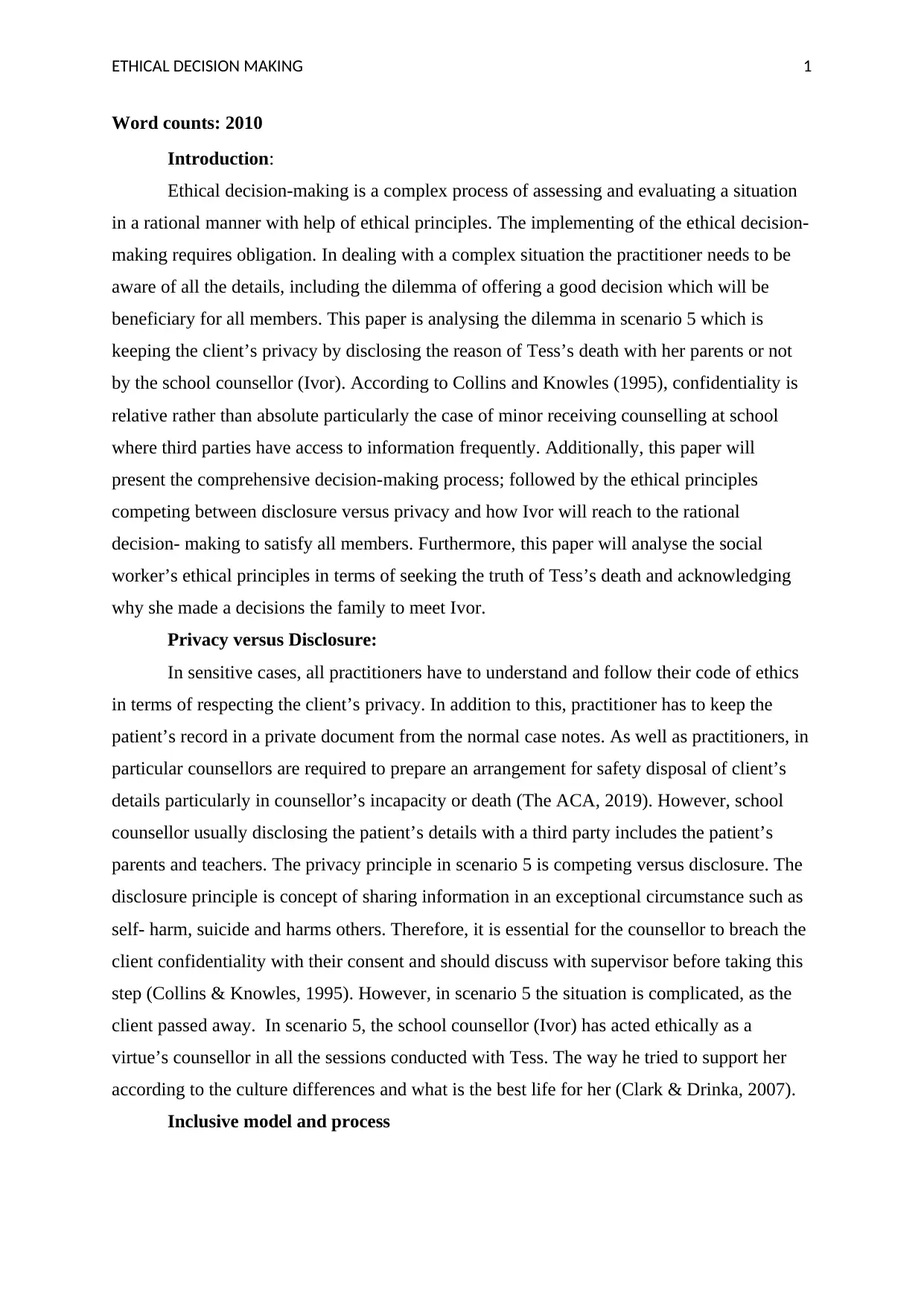
ETHICAL DECISION MAKING 1
Word counts: 2010
Introduction:
Ethical decision-making is a complex process of assessing and evaluating a situation
in a rational manner with help of ethical principles. The implementing of the ethical decision-
making requires obligation. In dealing with a complex situation the practitioner needs to be
aware of all the details, including the dilemma of offering a good decision which will be
beneficiary for all members. This paper is analysing the dilemma in scenario 5 which is
keeping the client’s privacy by disclosing the reason of Tess’s death with her parents or not
by the school counsellor (Ivor). According to Collins and Knowles (1995), confidentiality is
relative rather than absolute particularly the case of minor receiving counselling at school
where third parties have access to information frequently. Additionally, this paper will
present the comprehensive decision-making process; followed by the ethical principles
competing between disclosure versus privacy and how Ivor will reach to the rational
decision- making to satisfy all members. Furthermore, this paper will analyse the social
worker’s ethical principles in terms of seeking the truth of Tess’s death and acknowledging
why she made a decisions the family to meet Ivor.
Privacy versus Disclosure:
In sensitive cases, all practitioners have to understand and follow their code of ethics
in terms of respecting the client’s privacy. In addition to this, practitioner has to keep the
patient’s record in a private document from the normal case notes. As well as practitioners, in
particular counsellors are required to prepare an arrangement for safety disposal of client’s
details particularly in counsellor’s incapacity or death (The ACA, 2019). However, school
counsellor usually disclosing the patient’s details with a third party includes the patient’s
parents and teachers. The privacy principle in scenario 5 is competing versus disclosure. The
disclosure principle is concept of sharing information in an exceptional circumstance such as
self- harm, suicide and harms others. Therefore, it is essential for the counsellor to breach the
client confidentiality with their consent and should discuss with supervisor before taking this
step (Collins & Knowles, 1995). However, in scenario 5 the situation is complicated, as the
client passed away. In scenario 5, the school counsellor (Ivor) has acted ethically as a
virtue’s counsellor in all the sessions conducted with Tess. The way he tried to support her
according to the culture differences and what is the best life for her (Clark & Drinka, 2007).
Inclusive model and process
Word counts: 2010
Introduction:
Ethical decision-making is a complex process of assessing and evaluating a situation
in a rational manner with help of ethical principles. The implementing of the ethical decision-
making requires obligation. In dealing with a complex situation the practitioner needs to be
aware of all the details, including the dilemma of offering a good decision which will be
beneficiary for all members. This paper is analysing the dilemma in scenario 5 which is
keeping the client’s privacy by disclosing the reason of Tess’s death with her parents or not
by the school counsellor (Ivor). According to Collins and Knowles (1995), confidentiality is
relative rather than absolute particularly the case of minor receiving counselling at school
where third parties have access to information frequently. Additionally, this paper will
present the comprehensive decision-making process; followed by the ethical principles
competing between disclosure versus privacy and how Ivor will reach to the rational
decision- making to satisfy all members. Furthermore, this paper will analyse the social
worker’s ethical principles in terms of seeking the truth of Tess’s death and acknowledging
why she made a decisions the family to meet Ivor.
Privacy versus Disclosure:
In sensitive cases, all practitioners have to understand and follow their code of ethics
in terms of respecting the client’s privacy. In addition to this, practitioner has to keep the
patient’s record in a private document from the normal case notes. As well as practitioners, in
particular counsellors are required to prepare an arrangement for safety disposal of client’s
details particularly in counsellor’s incapacity or death (The ACA, 2019). However, school
counsellor usually disclosing the patient’s details with a third party includes the patient’s
parents and teachers. The privacy principle in scenario 5 is competing versus disclosure. The
disclosure principle is concept of sharing information in an exceptional circumstance such as
self- harm, suicide and harms others. Therefore, it is essential for the counsellor to breach the
client confidentiality with their consent and should discuss with supervisor before taking this
step (Collins & Knowles, 1995). However, in scenario 5 the situation is complicated, as the
client passed away. In scenario 5, the school counsellor (Ivor) has acted ethically as a
virtue’s counsellor in all the sessions conducted with Tess. The way he tried to support her
according to the culture differences and what is the best life for her (Clark & Drinka, 2007).
Inclusive model and process
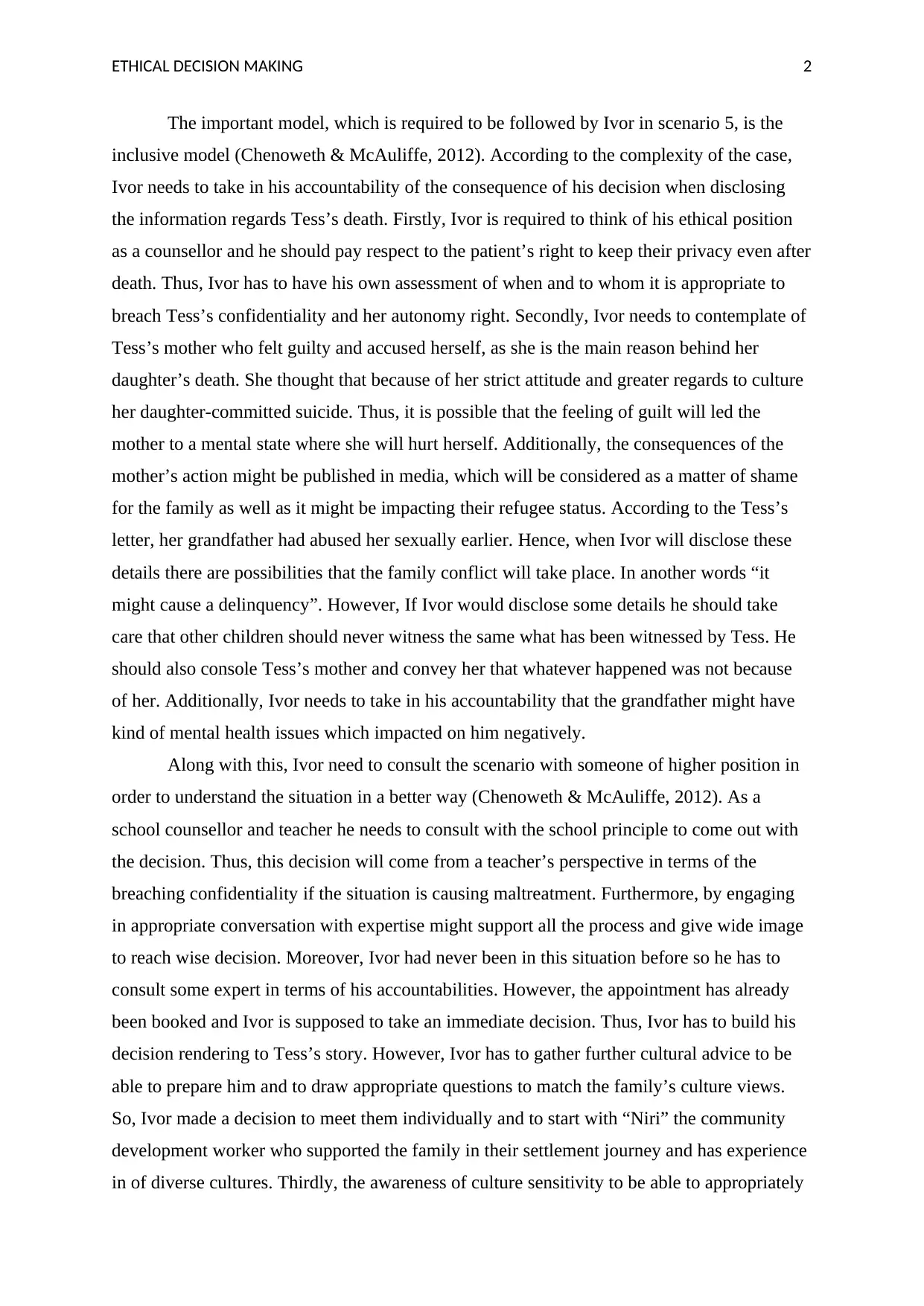
ETHICAL DECISION MAKING 2
The important model, which is required to be followed by Ivor in scenario 5, is the
inclusive model (Chenoweth & McAuliffe, 2012). According to the complexity of the case,
Ivor needs to take in his accountability of the consequence of his decision when disclosing
the information regards Tess’s death. Firstly, Ivor is required to think of his ethical position
as a counsellor and he should pay respect to the patient’s right to keep their privacy even after
death. Thus, Ivor has to have his own assessment of when and to whom it is appropriate to
breach Tess’s confidentiality and her autonomy right. Secondly, Ivor needs to contemplate of
Tess’s mother who felt guilty and accused herself, as she is the main reason behind her
daughter’s death. She thought that because of her strict attitude and greater regards to culture
her daughter-committed suicide. Thus, it is possible that the feeling of guilt will led the
mother to a mental state where she will hurt herself. Additionally, the consequences of the
mother’s action might be published in media, which will be considered as a matter of shame
for the family as well as it might be impacting their refugee status. According to the Tess’s
letter, her grandfather had abused her sexually earlier. Hence, when Ivor will disclose these
details there are possibilities that the family conflict will take place. In another words “it
might cause a delinquency”. However, If Ivor would disclose some details he should take
care that other children should never witness the same what has been witnessed by Tess. He
should also console Tess’s mother and convey her that whatever happened was not because
of her. Additionally, Ivor needs to take in his accountability that the grandfather might have
kind of mental health issues which impacted on him negatively.
Along with this, Ivor need to consult the scenario with someone of higher position in
order to understand the situation in a better way (Chenoweth & McAuliffe, 2012). As a
school counsellor and teacher he needs to consult with the school principle to come out with
the decision. Thus, this decision will come from a teacher’s perspective in terms of the
breaching confidentiality if the situation is causing maltreatment. Furthermore, by engaging
in appropriate conversation with expertise might support all the process and give wide image
to reach wise decision. Moreover, Ivor had never been in this situation before so he has to
consult some expert in terms of his accountabilities. However, the appointment has already
been booked and Ivor is supposed to take an immediate decision. Thus, Ivor has to build his
decision rendering to Tess’s story. However, Ivor has to gather further cultural advice to be
able to prepare him and to draw appropriate questions to match the family’s culture views.
So, Ivor made a decision to meet them individually and to start with “Niri” the community
development worker who supported the family in their settlement journey and has experience
in of diverse cultures. Thirdly, the awareness of culture sensitivity to be able to appropriately
The important model, which is required to be followed by Ivor in scenario 5, is the
inclusive model (Chenoweth & McAuliffe, 2012). According to the complexity of the case,
Ivor needs to take in his accountability of the consequence of his decision when disclosing
the information regards Tess’s death. Firstly, Ivor is required to think of his ethical position
as a counsellor and he should pay respect to the patient’s right to keep their privacy even after
death. Thus, Ivor has to have his own assessment of when and to whom it is appropriate to
breach Tess’s confidentiality and her autonomy right. Secondly, Ivor needs to contemplate of
Tess’s mother who felt guilty and accused herself, as she is the main reason behind her
daughter’s death. She thought that because of her strict attitude and greater regards to culture
her daughter-committed suicide. Thus, it is possible that the feeling of guilt will led the
mother to a mental state where she will hurt herself. Additionally, the consequences of the
mother’s action might be published in media, which will be considered as a matter of shame
for the family as well as it might be impacting their refugee status. According to the Tess’s
letter, her grandfather had abused her sexually earlier. Hence, when Ivor will disclose these
details there are possibilities that the family conflict will take place. In another words “it
might cause a delinquency”. However, If Ivor would disclose some details he should take
care that other children should never witness the same what has been witnessed by Tess. He
should also console Tess’s mother and convey her that whatever happened was not because
of her. Additionally, Ivor needs to take in his accountability that the grandfather might have
kind of mental health issues which impacted on him negatively.
Along with this, Ivor need to consult the scenario with someone of higher position in
order to understand the situation in a better way (Chenoweth & McAuliffe, 2012). As a
school counsellor and teacher he needs to consult with the school principle to come out with
the decision. Thus, this decision will come from a teacher’s perspective in terms of the
breaching confidentiality if the situation is causing maltreatment. Furthermore, by engaging
in appropriate conversation with expertise might support all the process and give wide image
to reach wise decision. Moreover, Ivor had never been in this situation before so he has to
consult some expert in terms of his accountabilities. However, the appointment has already
been booked and Ivor is supposed to take an immediate decision. Thus, Ivor has to build his
decision rendering to Tess’s story. However, Ivor has to gather further cultural advice to be
able to prepare him and to draw appropriate questions to match the family’s culture views.
So, Ivor made a decision to meet them individually and to start with “Niri” the community
development worker who supported the family in their settlement journey and has experience
in of diverse cultures. Thirdly, the awareness of culture sensitivity to be able to appropriately
⊘ This is a preview!⊘
Do you want full access?
Subscribe today to unlock all pages.

Trusted by 1+ million students worldwide
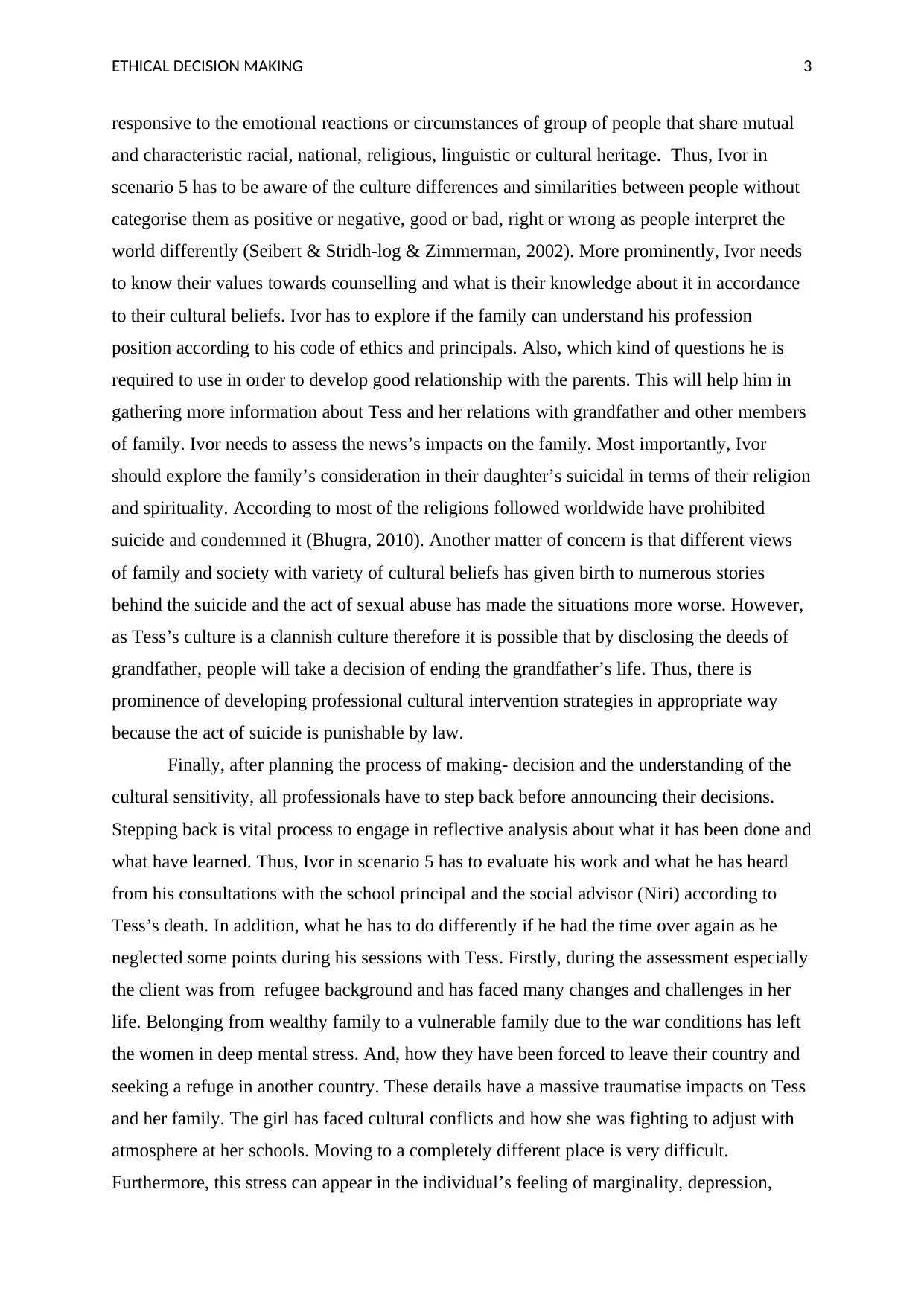
ETHICAL DECISION MAKING 3
responsive to the emotional reactions or circumstances of group of people that share mutual
and characteristic racial, national, religious, linguistic or cultural heritage. Thus, Ivor in
scenario 5 has to be aware of the culture differences and similarities between people without
categorise them as positive or negative, good or bad, right or wrong as people interpret the
world differently (Seibert & Stridh-log & Zimmerman, 2002). More prominently, Ivor needs
to know their values towards counselling and what is their knowledge about it in accordance
to their cultural beliefs. Ivor has to explore if the family can understand his profession
position according to his code of ethics and principals. Also, which kind of questions he is
required to use in order to develop good relationship with the parents. This will help him in
gathering more information about Tess and her relations with grandfather and other members
of family. Ivor needs to assess the news’s impacts on the family. Most importantly, Ivor
should explore the family’s consideration in their daughter’s suicidal in terms of their religion
and spirituality. According to most of the religions followed worldwide have prohibited
suicide and condemned it (Bhugra, 2010). Another matter of concern is that different views
of family and society with variety of cultural beliefs has given birth to numerous stories
behind the suicide and the act of sexual abuse has made the situations more worse. However,
as Tess’s culture is a clannish culture therefore it is possible that by disclosing the deeds of
grandfather, people will take a decision of ending the grandfather’s life. Thus, there is
prominence of developing professional cultural intervention strategies in appropriate way
because the act of suicide is punishable by law.
Finally, after planning the process of making- decision and the understanding of the
cultural sensitivity, all professionals have to step back before announcing their decisions.
Stepping back is vital process to engage in reflective analysis about what it has been done and
what have learned. Thus, Ivor in scenario 5 has to evaluate his work and what he has heard
from his consultations with the school principal and the social advisor (Niri) according to
Tess’s death. In addition, what he has to do differently if he had the time over again as he
neglected some points during his sessions with Tess. Firstly, during the assessment especially
the client was from refugee background and has faced many changes and challenges in her
life. Belonging from wealthy family to a vulnerable family due to the war conditions has left
the women in deep mental stress. And, how they have been forced to leave their country and
seeking a refuge in another country. These details have a massive traumatise impacts on Tess
and her family. The girl has faced cultural conflicts and how she was fighting to adjust with
atmosphere at her schools. Moving to a completely different place is very difficult.
Furthermore, this stress can appear in the individual’s feeling of marginality, depression,
responsive to the emotional reactions or circumstances of group of people that share mutual
and characteristic racial, national, religious, linguistic or cultural heritage. Thus, Ivor in
scenario 5 has to be aware of the culture differences and similarities between people without
categorise them as positive or negative, good or bad, right or wrong as people interpret the
world differently (Seibert & Stridh-log & Zimmerman, 2002). More prominently, Ivor needs
to know their values towards counselling and what is their knowledge about it in accordance
to their cultural beliefs. Ivor has to explore if the family can understand his profession
position according to his code of ethics and principals. Also, which kind of questions he is
required to use in order to develop good relationship with the parents. This will help him in
gathering more information about Tess and her relations with grandfather and other members
of family. Ivor needs to assess the news’s impacts on the family. Most importantly, Ivor
should explore the family’s consideration in their daughter’s suicidal in terms of their religion
and spirituality. According to most of the religions followed worldwide have prohibited
suicide and condemned it (Bhugra, 2010). Another matter of concern is that different views
of family and society with variety of cultural beliefs has given birth to numerous stories
behind the suicide and the act of sexual abuse has made the situations more worse. However,
as Tess’s culture is a clannish culture therefore it is possible that by disclosing the deeds of
grandfather, people will take a decision of ending the grandfather’s life. Thus, there is
prominence of developing professional cultural intervention strategies in appropriate way
because the act of suicide is punishable by law.
Finally, after planning the process of making- decision and the understanding of the
cultural sensitivity, all professionals have to step back before announcing their decisions.
Stepping back is vital process to engage in reflective analysis about what it has been done and
what have learned. Thus, Ivor in scenario 5 has to evaluate his work and what he has heard
from his consultations with the school principal and the social advisor (Niri) according to
Tess’s death. In addition, what he has to do differently if he had the time over again as he
neglected some points during his sessions with Tess. Firstly, during the assessment especially
the client was from refugee background and has faced many changes and challenges in her
life. Belonging from wealthy family to a vulnerable family due to the war conditions has left
the women in deep mental stress. And, how they have been forced to leave their country and
seeking a refuge in another country. These details have a massive traumatise impacts on Tess
and her family. The girl has faced cultural conflicts and how she was fighting to adjust with
atmosphere at her schools. Moving to a completely different place is very difficult.
Furthermore, this stress can appear in the individual’s feeling of marginality, depression,
Paraphrase This Document
Need a fresh take? Get an instant paraphrase of this document with our AI Paraphraser
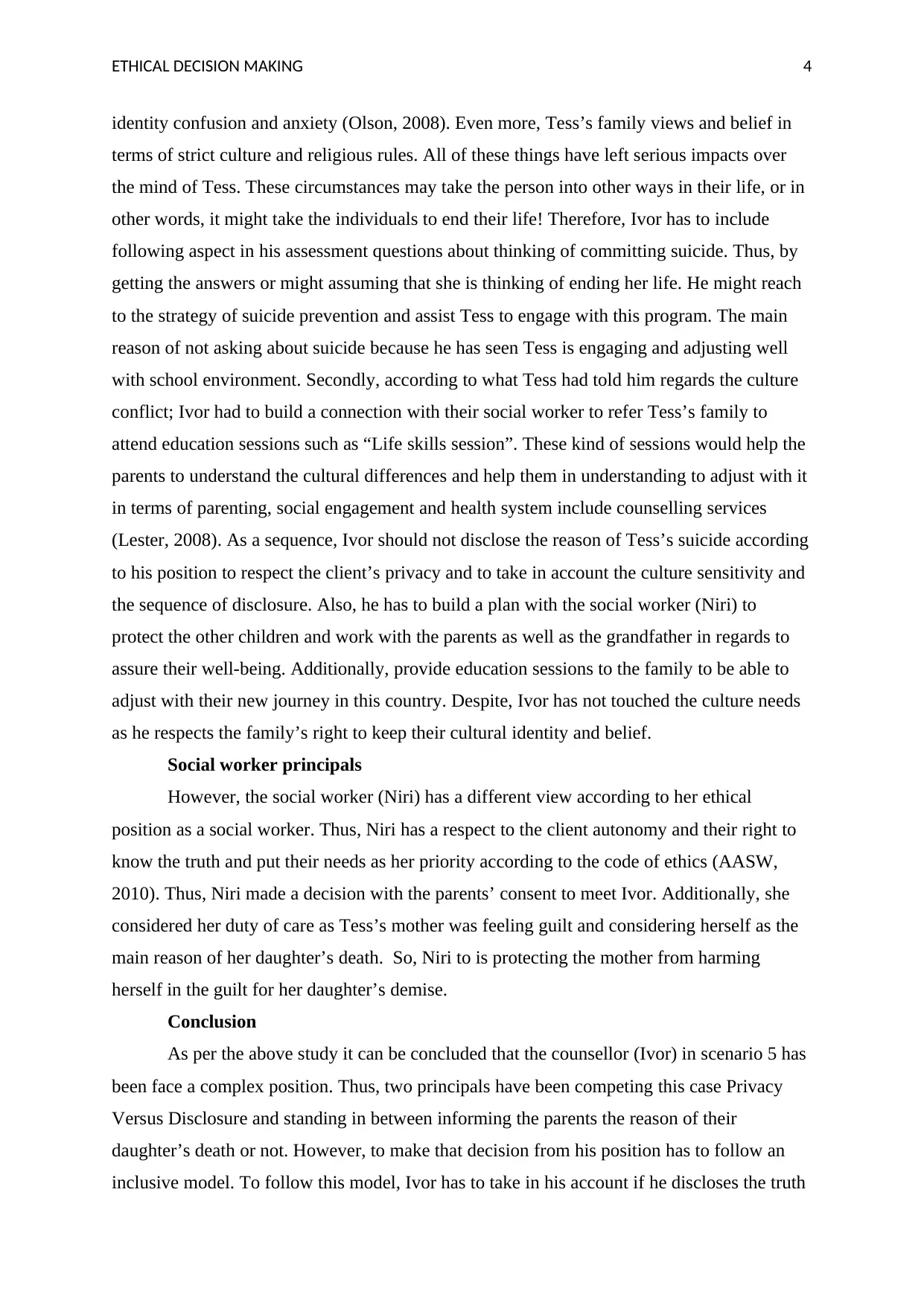
ETHICAL DECISION MAKING 4
identity confusion and anxiety (Olson, 2008). Even more, Tess’s family views and belief in
terms of strict culture and religious rules. All of these things have left serious impacts over
the mind of Tess. These circumstances may take the person into other ways in their life, or in
other words, it might take the individuals to end their life! Therefore, Ivor has to include
following aspect in his assessment questions about thinking of committing suicide. Thus, by
getting the answers or might assuming that she is thinking of ending her life. He might reach
to the strategy of suicide prevention and assist Tess to engage with this program. The main
reason of not asking about suicide because he has seen Tess is engaging and adjusting well
with school environment. Secondly, according to what Tess had told him regards the culture
conflict; Ivor had to build a connection with their social worker to refer Tess’s family to
attend education sessions such as “Life skills session”. These kind of sessions would help the
parents to understand the cultural differences and help them in understanding to adjust with it
in terms of parenting, social engagement and health system include counselling services
(Lester, 2008). As a sequence, Ivor should not disclose the reason of Tess’s suicide according
to his position to respect the client’s privacy and to take in account the culture sensitivity and
the sequence of disclosure. Also, he has to build a plan with the social worker (Niri) to
protect the other children and work with the parents as well as the grandfather in regards to
assure their well-being. Additionally, provide education sessions to the family to be able to
adjust with their new journey in this country. Despite, Ivor has not touched the culture needs
as he respects the family’s right to keep their cultural identity and belief.
Social worker principals
However, the social worker (Niri) has a different view according to her ethical
position as a social worker. Thus, Niri has a respect to the client autonomy and their right to
know the truth and put their needs as her priority according to the code of ethics (AASW,
2010). Thus, Niri made a decision with the parents’ consent to meet Ivor. Additionally, she
considered her duty of care as Tess’s mother was feeling guilt and considering herself as the
main reason of her daughter’s death. So, Niri to is protecting the mother from harming
herself in the guilt for her daughter’s demise.
Conclusion
As per the above study it can be concluded that the counsellor (Ivor) in scenario 5 has
been face a complex position. Thus, two principals have been competing this case Privacy
Versus Disclosure and standing in between informing the parents the reason of their
daughter’s death or not. However, to make that decision from his position has to follow an
inclusive model. To follow this model, Ivor has to take in his account if he discloses the truth
identity confusion and anxiety (Olson, 2008). Even more, Tess’s family views and belief in
terms of strict culture and religious rules. All of these things have left serious impacts over
the mind of Tess. These circumstances may take the person into other ways in their life, or in
other words, it might take the individuals to end their life! Therefore, Ivor has to include
following aspect in his assessment questions about thinking of committing suicide. Thus, by
getting the answers or might assuming that she is thinking of ending her life. He might reach
to the strategy of suicide prevention and assist Tess to engage with this program. The main
reason of not asking about suicide because he has seen Tess is engaging and adjusting well
with school environment. Secondly, according to what Tess had told him regards the culture
conflict; Ivor had to build a connection with their social worker to refer Tess’s family to
attend education sessions such as “Life skills session”. These kind of sessions would help the
parents to understand the cultural differences and help them in understanding to adjust with it
in terms of parenting, social engagement and health system include counselling services
(Lester, 2008). As a sequence, Ivor should not disclose the reason of Tess’s suicide according
to his position to respect the client’s privacy and to take in account the culture sensitivity and
the sequence of disclosure. Also, he has to build a plan with the social worker (Niri) to
protect the other children and work with the parents as well as the grandfather in regards to
assure their well-being. Additionally, provide education sessions to the family to be able to
adjust with their new journey in this country. Despite, Ivor has not touched the culture needs
as he respects the family’s right to keep their cultural identity and belief.
Social worker principals
However, the social worker (Niri) has a different view according to her ethical
position as a social worker. Thus, Niri has a respect to the client autonomy and their right to
know the truth and put their needs as her priority according to the code of ethics (AASW,
2010). Thus, Niri made a decision with the parents’ consent to meet Ivor. Additionally, she
considered her duty of care as Tess’s mother was feeling guilt and considering herself as the
main reason of her daughter’s death. So, Niri to is protecting the mother from harming
herself in the guilt for her daughter’s demise.
Conclusion
As per the above study it can be concluded that the counsellor (Ivor) in scenario 5 has
been face a complex position. Thus, two principals have been competing this case Privacy
Versus Disclosure and standing in between informing the parents the reason of their
daughter’s death or not. However, to make that decision from his position has to follow an
inclusive model. To follow this model, Ivor has to take in his account if he discloses the truth
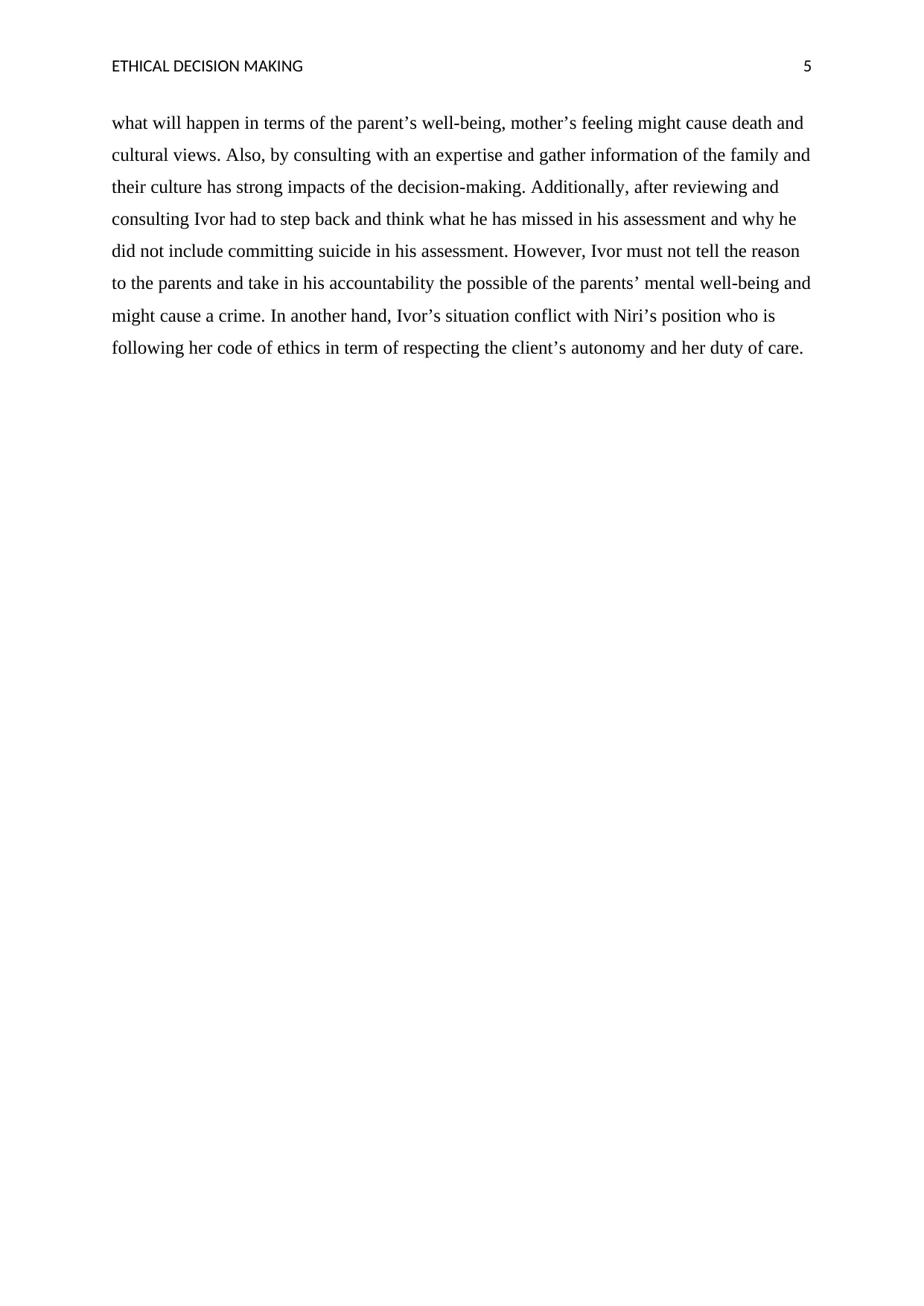
ETHICAL DECISION MAKING 5
what will happen in terms of the parent’s well-being, mother’s feeling might cause death and
cultural views. Also, by consulting with an expertise and gather information of the family and
their culture has strong impacts of the decision-making. Additionally, after reviewing and
consulting Ivor had to step back and think what he has missed in his assessment and why he
did not include committing suicide in his assessment. However, Ivor must not tell the reason
to the parents and take in his accountability the possible of the parents’ mental well-being and
might cause a crime. In another hand, Ivor’s situation conflict with Niri’s position who is
following her code of ethics in term of respecting the client’s autonomy and her duty of care.
what will happen in terms of the parent’s well-being, mother’s feeling might cause death and
cultural views. Also, by consulting with an expertise and gather information of the family and
their culture has strong impacts of the decision-making. Additionally, after reviewing and
consulting Ivor had to step back and think what he has missed in his assessment and why he
did not include committing suicide in his assessment. However, Ivor must not tell the reason
to the parents and take in his accountability the possible of the parents’ mental well-being and
might cause a crime. In another hand, Ivor’s situation conflict with Niri’s position who is
following her code of ethics in term of respecting the client’s autonomy and her duty of care.
⊘ This is a preview!⊘
Do you want full access?
Subscribe today to unlock all pages.

Trusted by 1+ million students worldwide
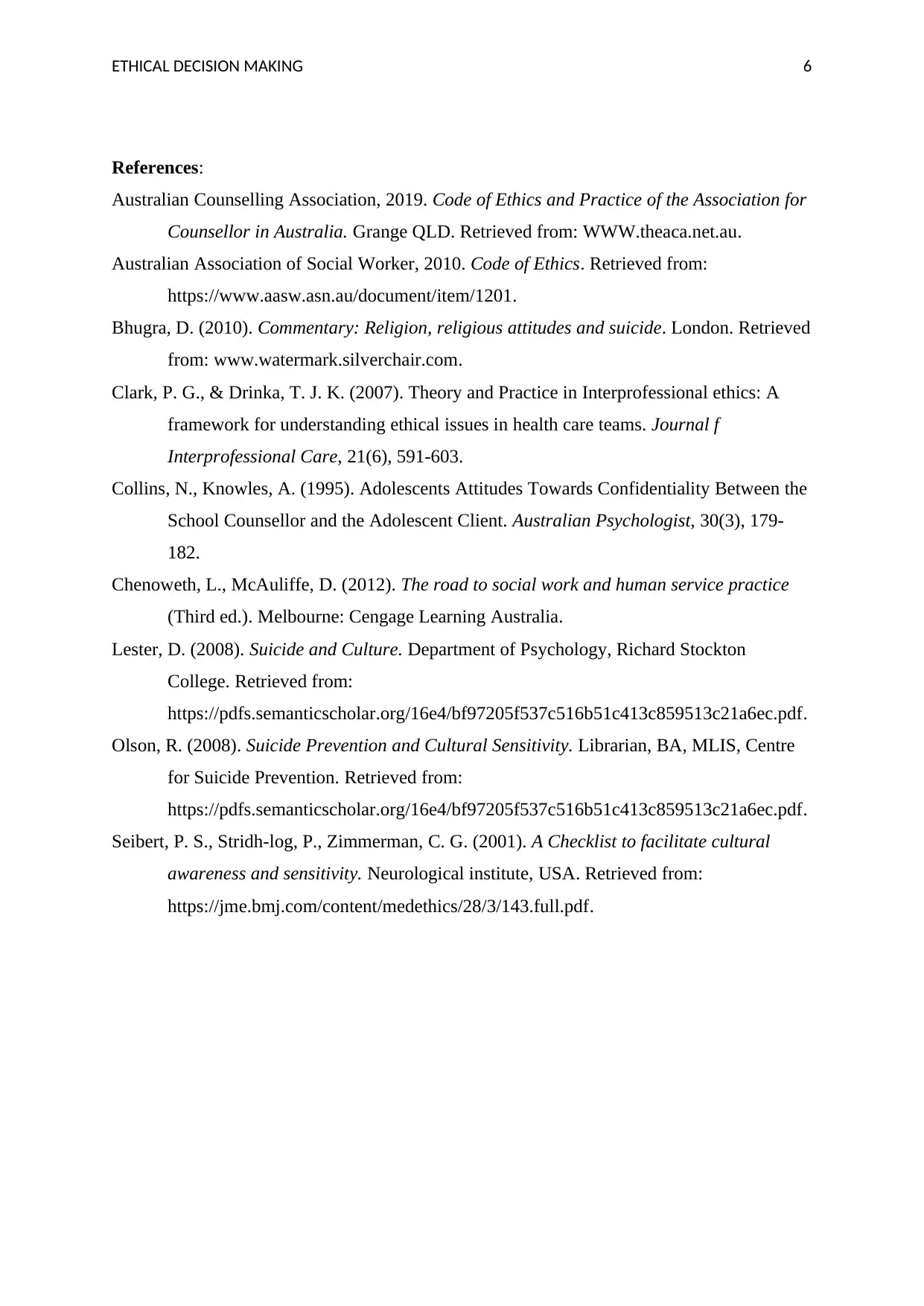
ETHICAL DECISION MAKING 6
References:
Australian Counselling Association, 2019. Code of Ethics and Practice of the Association for
Counsellor in Australia. Grange QLD. Retrieved from: WWW.theaca.net.au.
Australian Association of Social Worker, 2010. Code of Ethics. Retrieved from:
https://www.aasw.asn.au/document/item/1201.
Bhugra, D. (2010). Commentary: Religion, religious attitudes and suicide. London. Retrieved
from: www.watermark.silverchair.com.
Clark, P. G., & Drinka, T. J. K. (2007). Theory and Practice in Interprofessional ethics: A
framework for understanding ethical issues in health care teams. Journal f
Interprofessional Care, 21(6), 591-603.
Collins, N., Knowles, A. (1995). Adolescents Attitudes Towards Confidentiality Between the
School Counsellor and the Adolescent Client. Australian Psychologist, 30(3), 179-
182.
Chenoweth, L., McAuliffe, D. (2012). The road to social work and human service practice
(Third ed.). Melbourne: Cengage Learning Australia.
Lester, D. (2008). Suicide and Culture. Department of Psychology, Richard Stockton
College. Retrieved from:
https://pdfs.semanticscholar.org/16e4/bf97205f537c516b51c413c859513c21a6ec.pdf.
Olson, R. (2008). Suicide Prevention and Cultural Sensitivity. Librarian, BA, MLIS, Centre
for Suicide Prevention. Retrieved from:
https://pdfs.semanticscholar.org/16e4/bf97205f537c516b51c413c859513c21a6ec.pdf.
Seibert, P. S., Stridh-log, P., Zimmerman, C. G. (2001). A Checklist to facilitate cultural
awareness and sensitivity. Neurological institute, USA. Retrieved from:
https://jme.bmj.com/content/medethics/28/3/143.full.pdf.
References:
Australian Counselling Association, 2019. Code of Ethics and Practice of the Association for
Counsellor in Australia. Grange QLD. Retrieved from: WWW.theaca.net.au.
Australian Association of Social Worker, 2010. Code of Ethics. Retrieved from:
https://www.aasw.asn.au/document/item/1201.
Bhugra, D. (2010). Commentary: Religion, religious attitudes and suicide. London. Retrieved
from: www.watermark.silverchair.com.
Clark, P. G., & Drinka, T. J. K. (2007). Theory and Practice in Interprofessional ethics: A
framework for understanding ethical issues in health care teams. Journal f
Interprofessional Care, 21(6), 591-603.
Collins, N., Knowles, A. (1995). Adolescents Attitudes Towards Confidentiality Between the
School Counsellor and the Adolescent Client. Australian Psychologist, 30(3), 179-
182.
Chenoweth, L., McAuliffe, D. (2012). The road to social work and human service practice
(Third ed.). Melbourne: Cengage Learning Australia.
Lester, D. (2008). Suicide and Culture. Department of Psychology, Richard Stockton
College. Retrieved from:
https://pdfs.semanticscholar.org/16e4/bf97205f537c516b51c413c859513c21a6ec.pdf.
Olson, R. (2008). Suicide Prevention and Cultural Sensitivity. Librarian, BA, MLIS, Centre
for Suicide Prevention. Retrieved from:
https://pdfs.semanticscholar.org/16e4/bf97205f537c516b51c413c859513c21a6ec.pdf.
Seibert, P. S., Stridh-log, P., Zimmerman, C. G. (2001). A Checklist to facilitate cultural
awareness and sensitivity. Neurological institute, USA. Retrieved from:
https://jme.bmj.com/content/medethics/28/3/143.full.pdf.
1 out of 7
Related Documents
Your All-in-One AI-Powered Toolkit for Academic Success.
+13062052269
info@desklib.com
Available 24*7 on WhatsApp / Email
![[object Object]](/_next/static/media/star-bottom.7253800d.svg)
Unlock your academic potential
Copyright © 2020–2025 A2Z Services. All Rights Reserved. Developed and managed by ZUCOL.





